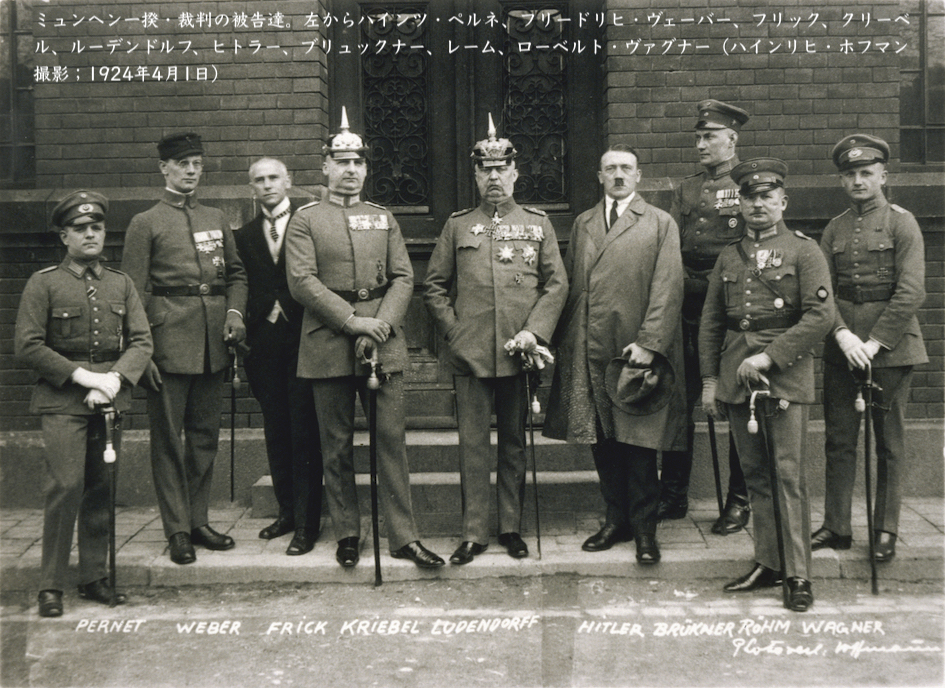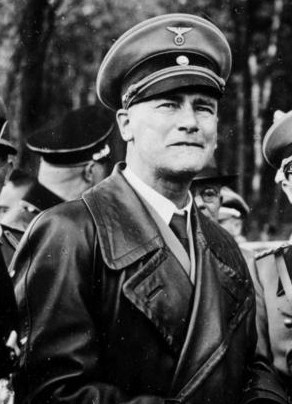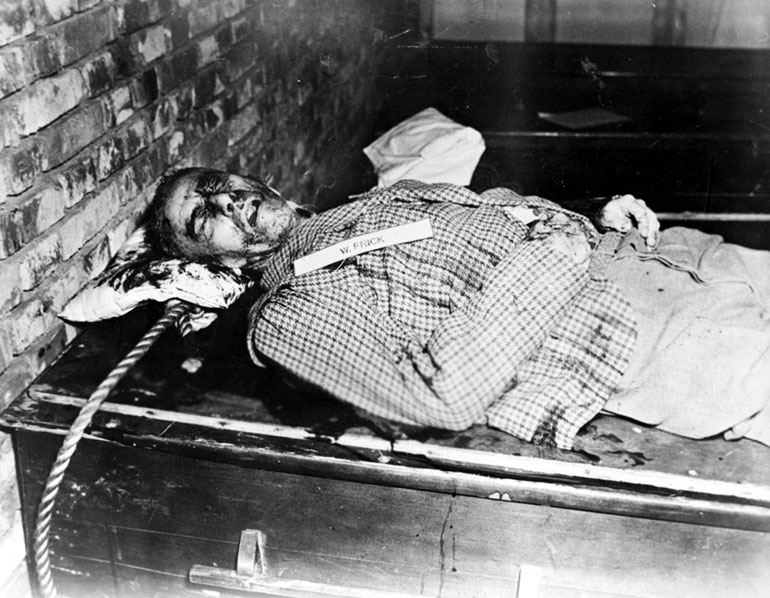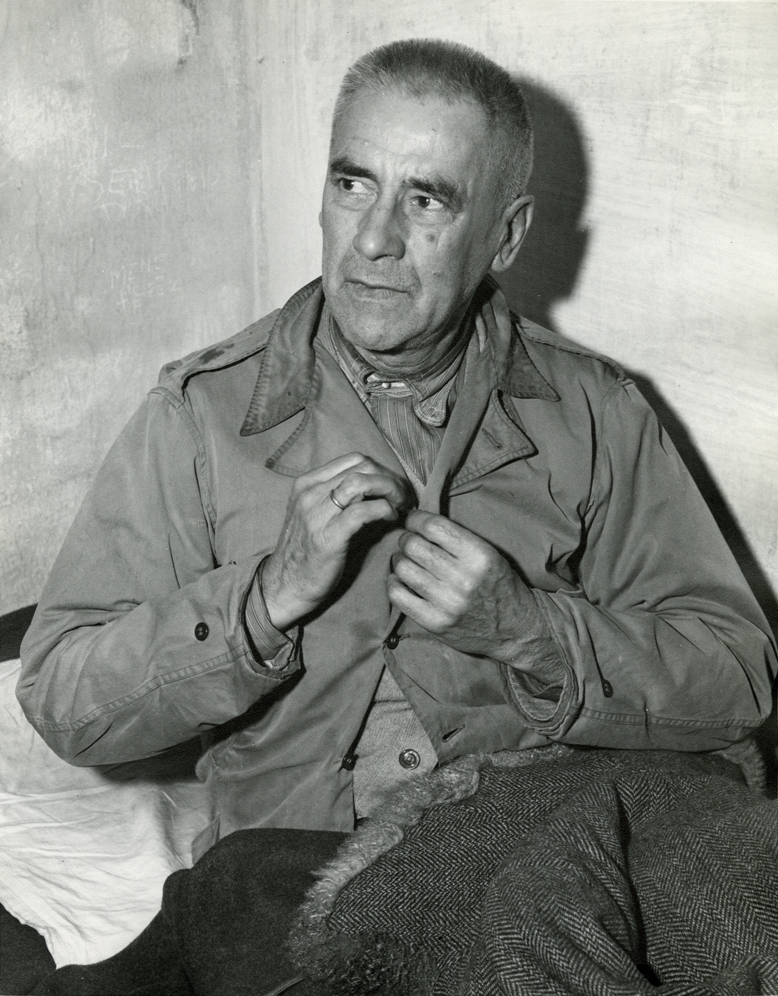ウィルヘルム・フリック
Wilhelm Frick, 1877-1946



Frick (3rd from left) among the defendants in the Munich Beer Hall Putsch trial, 1924/Frick visited in Sudetenland, 1938/1946年10月ニュルンベルクで処刑されたフリックの死体。罠の扉に頭をぶつけて負傷して流血している。
ウィルヘルム・フリック
Wilhelm Frick, 1877-1946



Frick (3rd from left) among the defendants in the Munich Beer Hall Putsch trial, 1924/Frick visited in Sudetenland, 1938/1946年10月ニュルンベルクで処刑されたフリックの死体。罠の扉に頭をぶつけて負傷して流血している。
ヴィルヘルム・フリック(Wilhelm Frick、1877年3月12日 - 1946年10月16日)は、ドイツのナチ党(NSDAP)の有力政治家で、1933年から1943年までアドルフ・ヒトラー内閣の内相を務め[1]、最 後のボヘミア、モラヴィア保護領の総督でもあった人物である。
| Wilhelm
Frick (12 March 1877 – 16 October 1946) was a prominent German
politician of the Nazi Party (NSDAP), who served as Reich Minister of
the Interior in Adolf Hitler's cabinet from 1933 to 1943[1] and as the
last governor of the Protectorate of Bohemia and Moravia. As the head of the Kriminalpolizei (criminal police) in Munich, Frick took part in Hitler's failed Beer Hall Putsch of 1923, for which he was convicted of high treason. He managed to avoid imprisonment and soon afterwards became a leading figure of the Nazi Party (NSDAP) in the Reichstag. After Hitler became Chancellor of Germany in 1933, Frick joined the new government and was named Reich Minister of the Interior. Additionally, on 21 May 1935, Frick was named Generalbevollmächtigter für die Reichsverwaltung (General Plenipotentiary for the Reich Administration).[2] He was instrumental in formulating laws that consolidated the Nazi regime (Gleichschaltung), as well as laws that defined the Nazi racial policy, most notoriously the Nuremberg Laws. On 30 August 1939, immediately prior to the outbreak of the Second World War, Frick was appointed by Hitler to the six-person Council of Ministers for Defense of the Reich which operated as a war cabinet.[3] Following the rise of the SS, Frick gradually lost favour within the party, and in 1943 he was replaced by Heinrich Himmler as interior minister. Frick remained in the cabinet as a minister without portfolio until Hitler's death in 1945. After World War II, Frick was tried and convicted of war crimes at the Nuremberg trials and executed by hanging. |
ヴィ
ルヘルム・フリック(Wilhelm Frick、1877年3月12日 -
1946年10月16日)は、ドイツのナチ党(NSDAP)の有力政治家で、1933年から1943年までアドルフ・ヒトラー内閣の内相を務め[1]、最
後のボヘミア、モラヴィア保護領の総督でもあった人物である。 ミュンヘンの刑事警察本部長として、1923年のヒトラーのビアホール一揆に参加し、大逆罪で有罪になった。しかし、投獄を免れ、その後、ナチス党 (NSDAP)の中心人物として帝国議会で活躍した。1933年、ヒトラーがドイツ首相に就任すると、フリックは新政府に参加し、帝国内相に就任した。 1935年5月21日、フリックは帝国行政全権大使に任命され、ナチス体制を強化する法律(Gleichschaltung)やナチスの人種政策を規定す る法律(最も有名なのはニュルンベルク法)の制定に貢献した[2]。第二次世界大戦勃発直前の1939年8月30日、フリックはヒトラーによって6人から なる帝国防衛相会議に任命され、戦争内閣として機能した[3]。 親衛隊の台頭によりフリックは次第に党内での人気を失い、1943年にハインリッヒ・ヒムラーに代わって内相となった。1945年にヒトラーが死去するま で、フリックは無任所大臣として内閣に留まった。 第二次世界大戦後、フリックはニュルンベルク裁判で戦争犯罪の裁きを受け、絞首刑に処された。 |
| Born
in the Palatinate municipality of Alsenz, then part of the Kingdom of
Bavaria, Germany, the last of four children of Protestant teacher
Wilhelm Frick sen. (d. 1918) and his wife Henriette (née Schmidt). He
attended the gymnasium in Kaiserslautern, passing his Abitur exams in
1896. He went on studying philology at the University of Munich, but
soon after turned to study law in Heidelberg and Humboldt University of
Berlin from 1900, he joined the Bavarian civil service in 1903, working
as an attorney at the Munich Police Department. He was appointed a
Bezirksamtassessor in Pirmasens in 1907 and became acting district
executive in 1914. Rejected as unfit, Frick did not serve in World War
I. He was promoted to the official rank of a Regierungsassessor and, at
his own request, re-assumed his post at the Munich Police Department in
1917.[4] On 25 April 1910, Frick married Elisabetha Emilie Nagel (1890–1978) in Pirmasens. They had two sons and a daughter. The marriage ended in an ugly divorce in 1934. A few weeks later, on 12 March, Frick remarried in Münchberg Margarete Schultze-Naumburg (1896–1960), the former wife of the Nazi Reichstag MP Paul Schultze-Naumburg. Margarete gave birth to a son and a daughter.[5] |
プ
ロテスタントの教師ヴィルヘルム・フリック(1918年没)とその妻ヘンリエット(旧姓シュミット)の4人の子供の末っ子として、当時バイエルン王国の一
部だったプファルツ地方のアルゼンツで生まれる。1896年にカイザースラウテルンのギムナジウムに入学し、アビトゥア試験に合格した。ミュンヘン大学で
言語学を学んだが、すぐにハイデルベルクと1900年からベルリンのフンボルト大学で法律を学ぶことになり、1903年にバイエルンの公務員になり、ミュ
ンヘン警察署で弁護士として働くようになった。1907年にピルマゼンスのベジルクザムトの監督官に任命され、1914年には地区行政官代理となった。第
一次世界大戦では戦力外通告を受け、兵役に就かなかったが、1917年、自らの希望によりレーゲルングスアッセッサーに昇格し、ミュンヘン警察署に再就職
した[4]。 1910年4月25日、フリックはピルマゼンスでエリザベッタ・エミリー・ナーゲル(1890-1978)と結婚した。二人の息子と一人の娘をもうけた。 1934年、この結婚は醜い離婚に終わった。その数週間後の3月12日、フリックはミュンヒベルクでマーガレット・シュルツェ・ナウンブルク(1896- 1960)と再婚した。マーガレットは一男一女を出産した[5]。 |
| In
Munich, Frick witnessed the end of the war and the German Revolution of
1918–1919. He sympathized with Freikorps paramilitary units fighting
against the Bavarian government of Premier Kurt Eisner. Chief of Police
Ernst Pöhner introduced him to Adolf Hitler, whom he helped willingly
with obtaining permissions to hold political rallies and demonstrations. Elevated to the rank of an Oberamtmann and head of the Kriminalpolizei (criminal police) from 1923, he and Pöhner participated in Hitler's failed Beer Hall Putsch on 9 November. Frick tried to suppress the State Police's operation, wherefore he was arrested and imprisoned, and tried for aiding and abetting high treason by the People's Court in April 1924. After several months in custody, he was given a suspended sentence of 15 months' imprisonment and was dismissed from his police job. Later during the disciplinary proceedings, the dismissal was declared unfair and revoked, on the basis that his treasonous intention had not been proven. Frick went on to work at the Munich social insurance office from 1926 onwards, in the rank of a Regierungsrat 1st class by 1933. In the aftermath of the putsch, Wilhelm Frick was elected a member of the German Reichstag parliament in the federal election of May 1924. He had been nominated by the National Socialist Freedom Movement, an electoral list of the far-right German Völkisch Freedom Party and then banned Nazi Party. On 1 September 1925, Frick joined the re-established Nazi Party. On 20 May 1928, he was one of the first 12 deputies elected to the Reichstag as Nazi Party members. He associated himself with the radical Gregor Strasser; making his name by aggressive anti-democratic and antisemitic Reichstag speeches, he climbed to the post of the Nazi parliamentary group leader (Fraktionsführer) in 1928.[6] He would continue to be elected to the Reichstag in every subsequent election in the Weimar and Nazi regimes. In 1929, as the price for joining the coalition government of the Land (state) of Thuringia, the NSDAP received the state ministries of the Interior and Education. On 23 January 1930, Frick was appointed to these ministries, becoming the first Nazi to hold a ministerial-level post at any level in Germany (though he remained a member of the Reichstag).[7] Frick used his position to dismiss Communist and Social Democratic officials and replace them with Nazi Party members, so Thuringia's federal subsidies were temporarily suspended by Reich Minister Carl Severing. Frick also appointed the eugenicist Hans F. K. Günther as a professor of social anthropology at the University of Jena, banned several newspapers, and banned pacifist drama and anti-war films such as All Quiet on the Western Front. He was removed from office by a Social Democratic motion of no confidence in the Thuringian Landtag parliament on 1 April 1931. |
ミュ
ンヘンでは、終戦と1918年から1919年にかけてのドイツ革命を目撃した。フリックは、バイエルン州首相のクルト・アイスナー政権に対抗して戦う準軍
事組織「フライコルプス」に共感した。警察署長エルンスト・ペーナーの紹介でアドルフ・ヒトラーと知り合い、政治集会やデモの許可取得に快く協力した。 1923年にはオーバーアムトマンに昇進し、刑事警察機構(Kriminalpolizei)の長官となり、ペーナーとともに11月9日のヒトラーのビア ホール一揆に参加し、失敗した。フリックは国家警察の作戦を制圧しようとしたため逮捕、投獄され、1924年4月に人民裁判所で大逆罪の幇助で裁判にかけ られた。数カ月の拘留の後、懲役15カ月の執行猶予がつき、警察官を解任された。その後、懲戒処分の過程で、反逆の意図は立証されなかったとして、解雇は 不当とされ、取り消された。フリックは1926年からミュンヘンの社会保険事務所に勤務し、1933年には一等書記官となった。 1924年5月の連邦議会選挙で、ドイツ連邦議会議員に選出されたのは、プーチの余波を受けたヴィルヘルム・フリックである。極右政党であるドイツ・ヴェ ルキッシュ自由党と、その後禁止されたナチ党の選挙リストである国家社会主義自由運動から推薦されたのである。1925年9月1日、フリックは再結成され たナチ党に入党した。1928年5月20日には、ナチ党員として初めて選出された12人の連邦議会議員の一人となった。急進派のグレゴール・シュトラッ サーと行動を共にし、反民主主義、反ユダヤ主義の積極的な帝国議会演説で名を上げ、1928年にはナチスの議会グループリーダー (Fraktionsführer)にまで上り詰めた[6] その後、ワイマール政権、ナチス政権のすべての選挙で帝国議会に選出され続けることとなる。 1929年、NSDAPはテューリンゲン州の連立政権に参加する代償として、内務省および教育省を獲得した。1930年1月23日、フリックはこれらの省 に任命され、ナチスとして初めてドイツのあらゆるレベルの大臣クラスのポストに就いた(ただし、彼は依然として帝国議会の議員であった)[7]。フリック はその地位を利用して、共産・社会民主党員を解任してナチス党員と交代させ、テューリンゲン州の連邦補助金は帝国大臣カール・セヴェリングによって一時的 に停止させられた。フリックはまた、優生学者ハンス・F・K・ギュンターをイエナ大学の社会人類学教授に任命し、いくつかの新聞を禁止し、平和主義ドラマや『西部戦線で静かに』などの反戦映画も禁止した。1931年4月1日、チューリンゲン州議会で社会民主党の不信任案が可決され、罷免された。 |
| When
Reich president Paul von Hindenburg appointed Hitler chancellor on 30
January 1933, Frick joined his government as Reichsminister of the
Interior. Together with Reichstag President Hermann Göring, he was one
of only two Nazi Reichsministers in the original Hitler Cabinet, and
the only one who actually had a portfolio; Göring served as minister
without portfolio until 5 May. Though Frick held a key position,
especially in organizing the federal elections of March 1933, he
initially had far less power than his counterparts in the rest of
Europe. Notably, he had no authority over the police; in Germany law
enforcement has traditionally been a state and local matter. Indeed,
the main reason that Hindenburg and Franz von Papen agreed to give the
Interior Ministry to the Nazis was that it was almost powerless at the
time. A mighty rival arose in the establishment of the Propaganda
Ministry under Joseph Goebbels on 13 March. Frick's power dramatically increased as a result of the Reichstag Fire Decree and the Enabling Act of 1933. The provision of the Reichstag Fire Decree giving the cabinet the power to take over state governments on its own authority was actually his idea; he saw the fire as a chance to increase his power and begin the process of Nazifying the country.[8] He was responsible for drafting many of the Gleichschaltung laws that consolidated the Nazi regime.[2] Within a few days of the Enabling Act's passage, Frick helped draft a law appointing Reichskommissare to disempower the state governments. Under the Law for the Reconstruction of the Reich, which converted Germany into a highly centralized state, the newly implemented Reichsstatthalter (state governors) were directly responsible to him. Frick also was made a member of Hans Frank's Academy for German Law.[9] On 10 October 1933, Hitler appointed him a Reichsleiter, the second highest political rank in the Nazi Party. In May 1934, he was appointed Prussian Minister of the Interior under Minister-President Göring, which gave him control over the police in Prussia. By 1935, he also had near-total control over local government. He had the sole power to appoint the mayors of all municipalities with populations greater than 100,000 (except for the city states of Berlin and Hamburg, where Hitler reserved the right to appoint the mayors himself if he deemed it necessary). He also had considerable influence over smaller towns as well; while their mayors were appointed by the state governors, as mentioned earlier the governors were responsible to him. Frick was instrumental in the racial policy of Nazi Germany drafting laws against Jewish citizens, like the "Law for the Restoration of the Professional Civil Service" and the notorious Nuremberg Laws in September 1935.[6] Already in July 1933, he had implemented the Law for the Prevention of Hereditarily Diseased Offspring including forced sterilizations, which later culminated in the killings of the Action T4 "euthanasia" programme supported by his ministry. Frick also took a leading part in Germany's re-armament in violation of the 1919 Versailles Treaty. He drafted laws introducing universal military conscription and extending the Wehrmacht service law to Austria after the 1938 Anschluss, as well as to the "Sudetenland" territories of the First Czechoslovak Republic annexed according to the Munich Agreement.[10] |
1933
年1月30日、パウル・フォン・ヒンデンブルク帝国大統領がヒトラーを首相に任命すると、フリックは内務大臣としてヒトラー政権に参加した。ゲーリングは
5月5日まで無任所大臣であったが、フリックはヘルマン・ゲーリングと共にヒトラー内閣で二人しかいないナチス帝国大臣の一人であり、実際にポートフォリ
オを持った唯一の人物であった。フリックは、特に1933年3月の連邦選挙を組織する上で重要な地位を占めたが、当初は他のヨーロッパの同業者に比べては
るかに小さな権力しか持っていなかった。特に警察に対する権限はなかった。ドイツでは、法の執行は伝統的に州や地方の問題であった。実際、ヒンデンブルグ
とフランツ・フォン・パーペンが内務省をナチスに譲渡することに同意した主な理由は、当時内務省がほとんど無力であったからである。3 月 13
日にヨーゼフ・ゲッペルスの下で宣伝省が設立され、強力なライバルが現れた。 フリックの権力が飛躍的に増大したのは、帝国議会火災令と1933年施行法の結果であった。帝国議会解散令の中で、内閣が独自の権限で州政府を買収する権 限を与えるという条項は、実は彼の発案であった。彼はこの火災を、自分の権力を増大し、国をナチス化するプロセスを開始するチャンスと考えた[8]。 彼はナチス体制を強化する多くのクライヒスシュタルト法の起草に責任を負っていた[2] 有効法が成立してから数日以内に、フリックは州政府から権限を奪うための国家委員会任命法の草案に協力した。ドイツを高度な中央集権国家へと転換させた 「帝国再建法」のもと、新たに導入されたライヒスシュタッター(州知事)はフリックに直接責任を負うことになった。1933年10月10日、ヒトラーは彼 をナチス党の2番目の政治的地位であるライヒスライターに任命した[9]。1934年5月には、ゲーリング大臣の下でプロイセン内相に任命され、プロイセ ンの警察を掌握することになった。1935年までには、地方行政もほぼ完全に掌握した。人口10万人以上のすべての自治体の市長を任命する権限を独占した (ただし、ベルリンとハンブルグの都市国家は、ヒトラーが必要と判断すれば自ら市長を任命する権利を留保していた)。市町村長は州知事によって任命された が、前述したように州知事はヒトラーに責任を負っていた。 1933年7月にはすでに強制不妊手術を含む「遺伝性疾患子孫防止法」を施行し、後に彼の省が支援したアクションT4「安楽死」計画による殺戮に至った [6]。フリックはまた、1919年のヴェルサイユ条約に違反したドイツの再軍備に主導的な役割を果たした。彼は国民皆兵制を導入する法律を起草し、ドイ ツ国防軍の兵役法を1938年の東西分離独立後のオーストリアとミュンヘン協定によって併合された第一チェコスロバキア共和国の「スデーテンランド」にも 拡大した[10]。 |
| In
the summer of 1938 Frick was named the patron (Schirmherr) of the
Deutsches Turn- und Sportfest in Breslau, a patriotic sports festival
attended by Hitler and much of the Nazi leadership. In this event he
presided the ceremony of "handing over" the new Nazi Reich Sports
League (NSRL) standard to Reichssportführer Hans von Tschammer und
Osten, marking the further nazification of sports in Germany.[11] On 11
November 1938, Frick promulgated the Regulations Against Jews'
Possession of Weapons. From the mid-to-late 1930s Frick lost favour irreversibly within the Nazi Party after a power struggle involving attempts to resolve the lack of coordination within the Reich government.[12] For example, in 1933 he tried to restrict the widespread use of "protective custody" orders that were used to send people to concentration camps, only to be begged off by Reichsführer-SS Heinrich Himmler. His power was greatly reduced in June 1936 when Hitler named Himmler the Chief of German Police, which effectively united the police with the SS. On paper, Frick was Himmler's immediate superior. In fact, the police were now independent of Frick's control, since the SS was responsible only to Hitler.[13][14] A long-running power struggle between the two culminated in Frick's being replaced by Himmler as Reichsminister of the Interior in August 1943. However, he remained in the cabinet as a Reichsminister without portfolio. Besides Hitler, he and Lutz Graf Schwerin von Krosigk were the only members of the Third Reich's cabinet to serve continuously from Hitler's appointment as Chancellor until his death. Frick's replacement as Reichsminister of the Interior did not reduce the growing administrative chaos and infighting between party and state agencies.[15] Frick was then appointed as Protector of Bohemia and Moravia, making him Hitler's personal representative in the Czech lands. Its capital Prague, where Frick used ruthless methods to counter dissent, was one of the last Axis-held cities to fall at the end of World War II in Europe.[16] |
1938
年夏、フリックはブレスラウで開催されたヒトラーとナチス指導者の多くが参加した愛国的スポーツフェスティバル「Deutsches Turn-
und
Sportfest」の後援者(Schirmherr)に任命された。このイベントで彼は、ナチス帝国スポーツリーグ(NSRL)の新しい規格を帝国ス
ポーツ総統ハンス・フォン・ツァンマー・ウント・オステンに「手渡す」儀式を主宰し、ドイツにおけるスポーツのナチス化をさらに進めることとなった
[11]。 1938年11月11日にフリックは「ユダヤ人の武器所持に対する規則」を公布している。 1930年代半ばから後半にかけて、フリックは帝国政府内の調整不足を解消しようとする権力闘争の結果、ナチ党内で不可逆的に人気を失った[12]。 例えば、1933年には強制収容所に送るための「保護拘束」命令の普及を制限しようとしたが、ハインリッヒ・ヒムラー親衛隊長に請われるだけであった。 1936年6月、ヒトラーがヒムラーをドイツ警察長官とし、警察とSSを事実上一体化させると、彼の権力は大きく低下した。フリックは書類上ではヒムラー の直属の上司であった。1943年8月、フリックはヒムラーと交代して帝国内務大臣に任命された。しかし、フリックは無任所大蔵大臣として内閣に留まっ た。ヒトラー以外の第三帝国内閣で、ヒトラーの首相就任から死去まで継続して在任したのは、彼とルッツ・グラーフ・シュヴェリン・フォン・クロジークだけ であった。 フリックが内務大臣に就任しても、行政の混乱や党と国家機関の間の内紛は収まらず[15]、フリックはボヘミアおよびモラヴィア保護官に任命され、チェコ の地でヒトラー個人を代表することができるようになった。首都プラハは、フリックが冷酷な手法で反対派に対抗したため、第二次世界大戦末期にヨーロッパで 陥落した最後の枢軸国支配都市のひとつとなった[16]。 |
| Trial and execution The corpse of Frick after his execution at Nuremberg, October 1946. Injuries caused from hitting his head on the trap door. Frick was arrested, and was arraigned at the Nuremberg trials, where he was the only defendant besides Rudolf Hess who refused to testify on his own behalf.[17] Frick was convicted of planning, initiating and waging wars of aggression, war crimes and crimes against humanity, and for his role, as Minister of the Interior, in formulating the Enabling Act and the Nuremberg Laws – laws under which people were deported to concentration camps, many of them being murdered there. Frick was also accused of being one of the most senior people responsible for the existence of the concentration camps.[10] Frick was sentenced to death on 1 October 1946, and was hanged at Nuremberg Prison on 16 October. Of his execution, journalist Joseph Kingsbury-Smith wrote: The sixth man to leave his prison cell and walk with handcuffed wrists to the death house was 69-year-old Wilhelm Frick. He entered the execution chamber at 2.05 am, six minutes after Rosenberg had been pronounced dead. He seemed the least steady of any so far and stumbled on the thirteenth step of the gallows. His only words were, "Long live eternal Germany", before he was hooded and dropped through the trap.[18][19] His body, along with those of the other nine executed men and the corpse of Hermann Göring, was cremated at the Ostfriedhof Cemetery in Munich, and the ashes were scattered in the river Isar.[20][21][22] |
 裁判と死刑執行 裁判と死刑執行フリックは逮捕され、ニュルンベルク裁判に召喚されたが、彼はルドルフ・ヘスの他に自分のために証言することを拒否した唯一の被告だった[17]。フリッ クは、侵略戦争の計画、開始、遂行、戦争犯罪、人道に対する罪、および内相として、強制収容所に人々を送還し多くの人々がそこで殺された法律である「実行 法」とニュルンベルク法の策定に関与したことにより有罪判決を下された。フリックはまた、強制収容所の存在に最も責任のある幹部の一人であると非難された [10]。 フリックは1946年10月1日に死刑を宣告され、10月16日にニュルンベルク刑務所で絞首刑に処された。彼の処刑について、ジャーナリストのジョセフ・キングスベリー=スミスはこう書いている。 獄舎を出て、手錠をかけられながら死刑台まで歩いてきた6番目の男は69歳のヴィルヘルム・フリックであった。ローゼンバーグの死亡宣告から6分後の午前 2時5分、彼は死刑執行室に入った。彼はこれまでの中で一番しっかりしていないように見え、絞首台の13段目でつまずいた。彼の唯一の言葉は「永遠のドイ ツに万歳する」というもので、その後フードを被せられ、罠から落とされた[18][19]。 彼の遺体は、他の9人の処刑人とヘルマン・ゲーリングの遺体とともにミュンヘンのオストフリードホーフ墓地で火葬され、遺灰はイザール川に撒かれた[20][21][22]。 |
| Glossary of Nazi Germany List of Nazi Party leaders and officials |
|
| https://en.wikipedia.org/wiki/Wilhelm_Frick |
https://www.deepl.com/ja/translator |
+++
Links
リンク
文献
その他の情報


